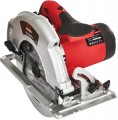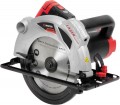No load blade speed
The maximum speed of the disk, provided by a saw of the appropriate design — disk, cut-off, etc. (see "Device").
Note that most of these saws use gearboxes, so that the blade revolutions are much lower than the engine revolutions (see above). This achieves an increase in torque, which in the case of saws is often more important than the high speed of the blade.
As for the specific number of revolutions, it is first of all worth noting that only saws with the same disc diameter can be compared according to this indicator. In these cases, higher speeds provide better performance, but the trade-off is reduced torque; such saws do better with relatively "light" materials. Conversely, low speeds reduce productivity, but allow the blade to effectively "bite" even into dense, stubborn workpieces. More specific recommendations regarding the choice of a saw according to the number of revolutions of the blade can be found in special sources.
Bore diameter
The diameter of the mounting hole for which the blade holder in the saw of the corresponding design is designed (see "Device"). In fact, this paragraph indicates the diameter of the axis on which the disk is installed — this size should correspond to the hole in the disk itself.
Note that some models of saws allow the installation of discs with larger holes than indicated in the specifications — when using an adapter sleeve. The main thing is that the own diameter of the disk does not exceed the values \u200b\u200ballowed for this model (see "Tyre / disk diameter"). Popular sizes include
20mm,
25mm and
30mm.
Cutting depth
The greatest depth of cut provided by the saw.
In most types of saws (see “Device”), the depth of cut directly depends on both the engine power and the size of the tyre / disk. The specifications give a value for the maximum allowable size of the working nozzle; when using nozzles of a smaller size, the depth of cut, respectively, will be less. But in band saws, this depth is rather weakly related to the actual length of the tape — it is determined primarily by the length of the open section of the tape, which is directly involved in the work.
Anyway, the greater depth of cut makes the tool more versatile, but comes at the cost of weight, price, and electricity/fuel consumption. So when choosing, it is worth considering the real features of the planned work and the dimensions of the workpieces that are planned to be cut. As for specific values, the most modest tools provide a depth
of up to 50 mm ;
50 – 75 mm is considered a low indicator,
75 – 100 mm is average,
100 – 125 mm is above average,
125 – 150 mm is already quite an impressive thickness, and the most powerful modern saws can have a cutting depth
of more than 150 mm.
Cutting depth (45° angle)
Maximum cutting depth achieved when sawing at a 45° bevel.
This feature is indicated only for those models that are originally designed for sawing at an angle — for example, due to the special design of the attachment for the blade / blade (in stationary models, see "Type") or due to the inclined support platform (in manual) . The maximum angle of inclination of the saw in such models can be different (see below for more details), however, 45 ° is considered the standard option, so it is for this inclination that data on the depth of cut is given.
The general meaning of this parameter is quite obvious. On the one hand, a greater depth of cut allows you to cope with thicker workpieces and generally gives you more options; on the other hand, an increase in depth requires an increase in the size of the disk / canvas and an increase in power, which, accordingly, affects the price, dimensions and consumption of electricity / fuel.
Weight
The total weight of the tool. For petrol models (see "Power Source"), usually, dry weight is indicated, excluding fuel.
In general, it makes sense to pay attention to this parameter primarily when choosing a hand tool. At the same time, note that higher power, a more capacious battery or a capacious tank will inevitably affect weight. However, tools with similar characteristics can and do differ markedly in weight. And here it is worth considering that a lighter model will be more comfortable to work with, but weight reduction may affect reliability and/or cost. In addition, a more massive tool is more stable, it is not so prone to jerks under uneven loads. If we talk about specific numbers, then a weight of
3 kg or less is considered very light,
3–5 kg is relatively small,
5–7 kg is medium,
7–10 kg is significant, and some powerful tools (mainly gasoline) weigh and
over 10 kg.
As for stationary saws, weight is of secondary importance for them — it mainly affects the ease of transportation.

